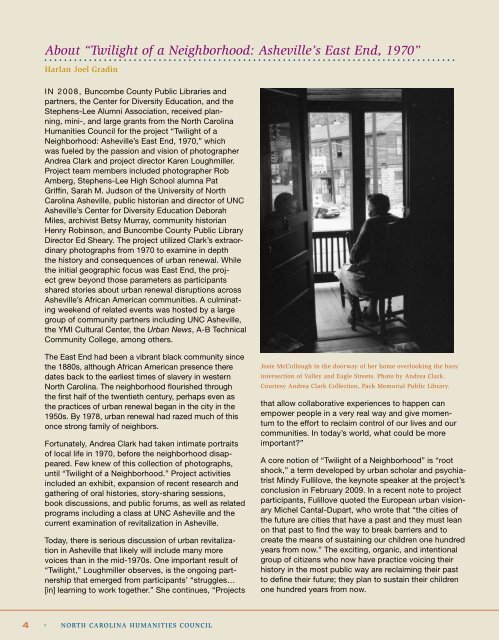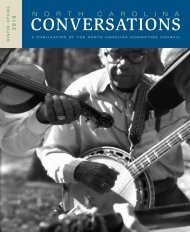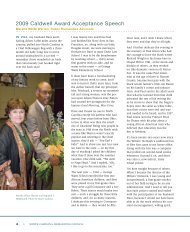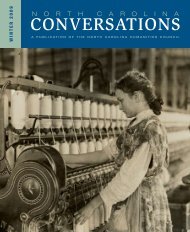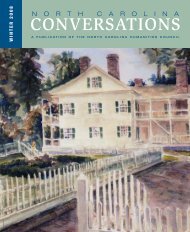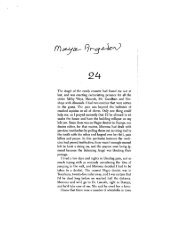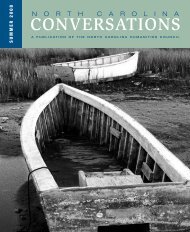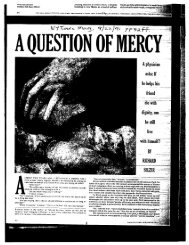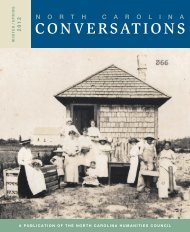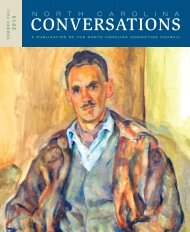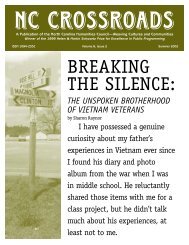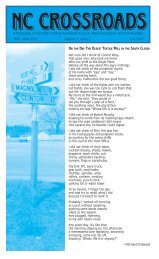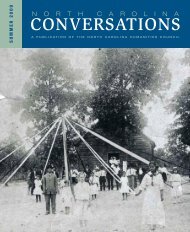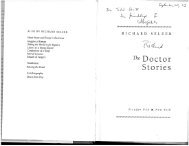Twilight of a Neighborhood - North Carolina Humanities Council
Twilight of a Neighborhood - North Carolina Humanities Council
Twilight of a Neighborhood - North Carolina Humanities Council
You also want an ePaper? Increase the reach of your titles
YUMPU automatically turns print PDFs into web optimized ePapers that Google loves.
About “<strong>Twilight</strong> <strong>of</strong> a <strong>Neighborhood</strong>: Asheville’s East End, 1970”<br />
Harlan Joel Gradin<br />
in 2008, Buncombe County Public Libraries and<br />
partners, the Center for Diversity Education, and the<br />
Stephens-Lee Alumni Association, received planning,<br />
mini-, and large grants from the north <strong>Carolina</strong><br />
<strong>Humanities</strong> <strong>Council</strong> for the project “<strong>Twilight</strong> <strong>of</strong> a<br />
neighborhood: Asheville’s East End, 1970,” which<br />
was fueled by the passion and vision <strong>of</strong> photographer<br />
Andrea Clark and project director Karen Loughmiller.<br />
Project team members included photographer rob<br />
Amberg, Stephens-Lee High School alumna Pat<br />
griffin, Sarah M. Judson <strong>of</strong> the University <strong>of</strong> north<br />
<strong>Carolina</strong> Asheville, public historian and director <strong>of</strong> UnC<br />
Asheville’s Center for Diversity Education Deborah<br />
Miles, archivist Betsy Murray, community historian<br />
Henry robinson, and Buncombe County Public Library<br />
Director Ed Sheary. The project utilized Clark’s extraordinary<br />
photographs from 1970 to examine in depth<br />
the history and consequences <strong>of</strong> urban renewal. while<br />
the initial geographic focus was East End, the project<br />
grew beyond those parameters as participants<br />
shared stories about urban renewal disruptions across<br />
Asheville’s African American communities. A culminating<br />
weekend <strong>of</strong> related events was hosted by a large<br />
group <strong>of</strong> community partners including UnC Asheville,<br />
the YMi Cultural Center, the Urban News, A-B Technical<br />
Community College, among others.<br />
The East End had been a vibrant black community since<br />
the 1880s, although African American presence there<br />
dates back to the earliest times <strong>of</strong> slavery in western<br />
north <strong>Carolina</strong>. The neighborhood flourished through<br />
the first half <strong>of</strong> the twentieth century, perhaps even as<br />
the practices <strong>of</strong> urban renewal began in the city in the<br />
1950s. By 1978, urban renewal had razed much <strong>of</strong> this<br />
once strong family <strong>of</strong> neighbors.<br />
Fortunately, Andrea Clark had taken intimate portraits<br />
<strong>of</strong> local life in 1970, before the neighborhood disappeared.<br />
Few knew <strong>of</strong> this collection <strong>of</strong> photographs,<br />
until “<strong>Twilight</strong> <strong>of</strong> a neighborhood.” Project activities<br />
included an exhibit, expansion <strong>of</strong> recent research and<br />
gathering <strong>of</strong> oral histories, story-sharing sessions,<br />
book discussions, and public forums, as well as related<br />
programs including a class at UnC Asheville and the<br />
current examination <strong>of</strong> revitalization in Asheville.<br />
Today, there is serious discussion <strong>of</strong> urban revitalization<br />
in Asheville that likely will include many more<br />
voices than in the mid-1970s. One important result <strong>of</strong><br />
“<strong>Twilight</strong>,” Loughmiller observes, is the ongoing partnership<br />
that emerged from participants’ “struggles…<br />
[in] learning to work together.” She continues, “Projects<br />
4 • NORtH CAROLiNA HuMANitiES COuNCiL<br />
Josie McCullough in the doorway <strong>of</strong> her home overlooking the busy<br />
intersection <strong>of</strong> Valley and Eagle Streets. Photo by Andrea Clark.<br />
Courtesy Andrea Clark Collection, Pack Memorial Public Library.<br />
that allow collaborative experiences to happen can<br />
empower people in a very real way and give momentum<br />
to the effort to reclaim control <strong>of</strong> our lives and our<br />
communities. in today’s world, what could be more<br />
important?”<br />
A core notion <strong>of</strong> “<strong>Twilight</strong> <strong>of</strong> a neighborhood” is “root<br />
shock,” a term developed by urban scholar and psychiatrist<br />
Mindy Fullilove, the keynote speaker at the project’s<br />
conclusion in February 2009. in a recent note to project<br />
participants, Fulillove quoted the European urban visionary<br />
Michel Cantal-Dupart, who wrote that “the cities <strong>of</strong><br />
the future are cities that have a past and they must lean<br />
on that past to find the way to break barriers and to<br />
create the means <strong>of</strong> sustaining our children one hundred<br />
years from now.” The exciting, organic, and intentional<br />
group <strong>of</strong> citizens who now have practice voicing their<br />
history in the most public way are reclaiming their past<br />
to define their future; they plan to sustain their children<br />
one hundred years from now.


